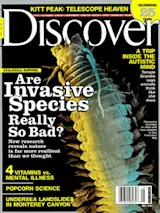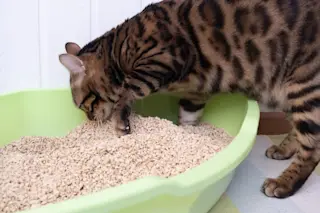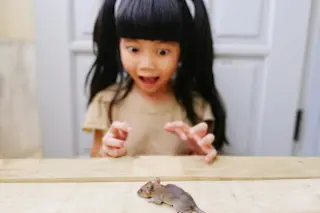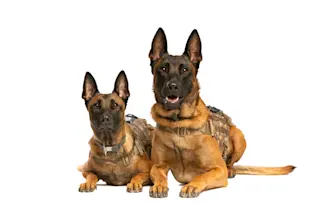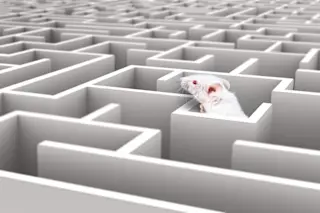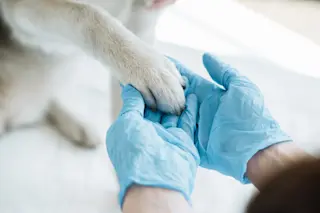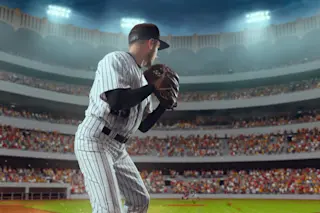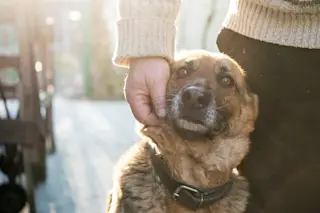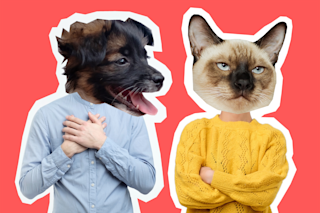If you live with animals, the real question isn’t whether they can think or not. It’s “What do they think of humans?” I often find myself mulling that over when I go out to gather eggs or feed the pigs. It isn’t a personal question—Have I earned the horses’ respect?—it’s a philosophical one. Living with animals means coming to terms with who they are and what makes them tick. That’s what you want to know when you train a dog or ride a horse or try to catch a barnyard goose. At least that’s what I want to know. I live and write on a small farm in New York State, and since my work, most days, means asking questions about the world around me, I find myself wondering about the animals I live with. I take it for granted that they also wonder about me. I can see the questions in their eyes, in the tilt of their ears: Who are these humans? Why do they behave the way they do?
There’s no point asking these questions of the cattle staring at me on this warm November Sunday. They won’t answer, not in so many words. But if I ask the woman standing beside me—the cattle are staring at her too—I’m likely to find some answers. That’s because the woman is Temple Grandin.
The cattle were dozing, perhaps a hundred of them in several long pens a few minutes north of Fort Collins, Colorado. Then we showed up. The steers roused and strode toward us, following their curiosity. They would have walked right up to us, as near as their caution allowed, if they could have. They stand at the fence, head-on, impassive, like the Charolais they are—patient, buff-colored animals.
Say the words cattle, autistic, and woman, and a surprising number of Americans will come up with the name of Temple Grandin. Thanks to her writings, and those of Oliver Sacks, she is perhaps the best-known autistic person in America.
And if you eat at fast-food restaurants—McDonald’s, Wendy’s, Kentucky Fried Chicken—you’re eating meat that’s been slaughtered in plants audited to Grandin’s standards, meat from cattle and pigs that walked calmly to their fate through handling systems she designed. In the human scheme of things, those animals are economic units whose death is inevitable. By designing chutes and alleys that respect a cow’s sensibilities—reducing its fear and uncertainty—Grandin has done more to improve animal welfare than almost any human alive. Increasing a cow’s comfort as it nears death may seem like a futile subtlety to many humans. But fear is one of the critical differences between humane and inhumane slaughter. It also happens to be one of the differences between good meat and bad.
Grandin defines what works when it comes to handling cattle in feedlots and slaughterhouses because she defines it from the cow’s point of view. Because of her autism, she’s able to see what cattle see and humans don’t. She understands, for instance, that even a tiny thing, like a harsh lighting contrast, will startle cattle, stopping them in their tracks. She knows that fear is a landmark emotion for a cow, just as it is for an autistic person. “You can’t get anything past a cow,” she writes. She knows this partly because you can’t get anything past an autistic person either.
In her new book, Animals in Translation: Using the Mysteries of Autism to Decode Animal Behavior, Grandin examines the surprising similarities between an animal’s mind and an autistic mind—her own. “Autistic people,” she writes, “are closer to animals than normal people are.” This may sound like a cruel judgment, the sort of thing a cold-hearted clinician would say, but it isn’t. It’s an acute observation, all the more important because it comes from an autistic person. Her autism, Grandin suggests, puts her somewhere between normal human mentality and animal mentality, not as a matter of IQ but as a matter of perception and emotion. Being closer to animals isn’t necessarily a bad thing. After all, that’s what makes Grandin such an uncanny translator of animal behavior.
Scientists and animal trainers (and plenty of ordinary people) have devoted their lives to trying to understand what the world looks like to animals. After all, the planet teems with perceptive creatures—of whom we are a small minority—and it’s more than a matter of idle curiosity to consider how life appears to them. Humans can’t help approaching this problem from a human perspective. We posit our own intelligence, our behavior, emotions, and language skills, as the norm. A horse-trainer friend of mine is often asked if horses are intelligent. “It depends who’s writing the test,” he likes to say. I’ve often wondered how it would turn out if humans weren’t the ones writing the tests, defining the norm.
What if we accepted the sensitivity, the acute worldliness of a dog or a horse or a cougar as the norm? What would humans look like if we were measured from a crow’s perspective? What kind of theory of human consciousness would a good-natured pig or an inquisitive dolphin arrive at?
A curious thing happens in Animals in Translation. Grandin sets out to portray the mental and emotional character of animals and its resemblance to that of autistic people—all of it set against the familiar backdrop of normal human intelligence and behavior. But what emerges, almost incidentally, is a fascinating portrait of “normal people” from her perspective and, by analogy, from the perspective of animals too. Reading Animals in Translation is like looking at a photographic negative of ordinary human behavior and consciousness. This is perhaps as close as most of us will come to seeing humans through animal eyes. Humans may be “regular” and “normal,” but it’s clear that, by animal and autistic standards, we’re also very strange.
Grandin and I came to the cattle yard to inspect one of her handling facilities: gathering pens, a crowding pen, a curving single-file alley with solid sides leading to a squeeze chute, where cows are restrained, one by one, and given their shots. All of this is arrayed in a sinuous curve whose beauty is readily discernible in Grandin’s detailed drawings (see “Stairway to Heaven,” below). The layout looks baffling at first, until you realize how simple it really is—a conduit for cows the way a hose is a conduit for water. Behind that simplicity lies a profound perception of a cow’s world order. What moves the cattle through the welded steel chutes isn’t fear or force or pressure. It’s simply the desire to stay with the herd.
Grandin’s corrals are an expression of what she can see and most people can’t. For her, sight is more than a metaphor. She thinks in pictures, one slide, one video, after another. The pictures are both memories and thoughts, and they occur in a nonverbal isolation that’s hard for a normal person to imagine. At breakfast Grandin explained to me how easy it is for autistic people to find a figure hidden in a complex picture—a test called the Embedded Figure Task. Normal people have trouble seeing it, but it jumps right out at an autistic person. When she lectures, Grandin uses a slide to illustrate what the brain scan of an autistic person looks like during a hidden-figure test. She says that slide is as close as she comes to abstract thinking.
“It’s a little bright cabin out in the snowy wilderness,” she explains. “Everything else is shut off, but the visual center is turned on really bright.” In contrast, the brain of a normal person doing that test resembles a lamp store. “There’s so much stuff turned on,” Grandin says, “that the visual stuff gets obscured.” The difference between a normal person’s mental clutter and the intense, detailed absorption of an autistic person’s visual concentration closely resembles the difference between humans and animals.
When Grandin teaches people how to handle livestock, the subtext isn’t so much what she notices—she takes that for granted, after all. It’s what ordinary people don’t notice and, especially, how they don’t notice. The surprise that normal people feel when they realize how much Grandin sees has been more than matched over the years by her surprise at how much ordinary people fail to see. The difference can be summed up in a relatively simple manner, though the underlying biology is complex. A cow sees everything in detail and responds to details. Like an autistic person, its fears are hyperspecific because its perception is hyperspecific. But normal humans tend to see only what they expect to see.
We’re used to the idea that human thought is abstract. But what Grandin points out is that even the sensory perception of ordinary humans is abstract as well. “Normal people,” she writes, “see and hear schemas, not raw sensory data.” It’s a refrain I hear several times that day. At lunch with her assistant, Mark Deesing, Grandin talked, for instance, about how badly designed airport concourses and parking lots tend to be. Some of this she blames on the shift to computerized drafting programs and the loss of manual drafting skills. But the underlying fault is a lack of visual perception.
“They don’t see it,” she says of the designers. “They just don’t see it—things that are obvious to me. I remember watching this monster movie when I was a kid, and they had this monster locked in this box in a lab. Couldn’t they see he would reach the latch and open it? It was just a stupid movie, but now I’m finding people do these same kinds of stupid things in real situations.”
It’s easy to imagine an engineer not being able to visualize a design flaw in a complex structure. What’s harder to take in is the everyday blindness of ordinary people. Humans, Grandin writes, “are built to see what they’re expecting to see, and it’s hard to expect to see something you’ve never seen. New things just don’t register.” Animals, on the other hand, “definitely act like they see everything.” New things not only register to cows, they positively throb with significance. The solid-sided chutes on Grandin’s cattle-handling facilities are intended to prevent cattle from seeing new things. Cattle handlers have to learn two things from Grandin. They have to learn that a Styrofoam cup, for example, lying in an alleyway will stop cow traffic dead because it worries the cattle. But first the handlers have to learn to see the cup.
Grandin uses an awkward but powerful word to describe the perceptual fog that normal humans live in. She calls it “abstractification.” It means the ability to live in our thoughts, surrounded by “our ideas of things.” “Normal human beings,” she writes, “are abstractified in their sensory perceptions as well as their thoughts.” This is partly what makes us human. But one of the things Grandin worries about is the increasing tendency of humans to live utterly abstractified lives, cut off from tactile participation in the real, physical world. She laments the way schools have dropped classes like wood shop and metal shop and drafting—the kinds of classes that saved her when she was going to school and failing classes like algebra.
Those changes directly affect autistic children. But normal humans are experiencing a similar loss. We surround ourselves with television and computer games. We practically live in our offices. We inhabit a cocoon of associations and representations of the world around us—increasingly a world divorced from nature. Grandin’s battles in the slaughter industry have nearly all been waged with higher management, not with workers or floor managers, simply because they’re office bound, their thinking determined more by the paper that surrounds them than by living animals and working plants.
The result, according to Grandin, is a pattern that might be called the radicalism of inexperience. “People,” she says, “that live in offices—I don’t care if they’re to the right or the left of an issue—the more far removed they are from practical things, the more radical they get.” This is what happens when humans cut the anchor and drift away from practical experience and, especially, from the experience of nature and the world of animals. We lose the comparative frame that helps us balance our lives.
There’s a close analogy to that radicalism—abstractification abstractifying itself even further—in the business of breeding animals for industrialized agriculture. Grandin has inspected hundreds of packing plants and feedlots and seen hundreds of thousands—if not millions—of hogs. She tells me about a problem that crept up on breeders trying to create extralean pigs. She would walk through a yard, “shaking gates,” as she puts it. “I noticed that these pigs were absolutely hyper. They slowly got more excitable. If the only pigs you see are those pigs, then you don’t realize how bad they’re getting. I call that bad becoming normal.” The same thing has happened in chicken breeding.
That development pattern—bad becoming normal—is made possible by two things: human adaptability to shifting circumstances and cutting away a comparative frame of reference. If you see only the results of your own breeding program—never any fat, happy pigs with good conformation—it’s easy to lose sight of how much their behavior has changed, especially if you’re focusing exclusively on developing physical traits. Without a standard to refer back to—happy, healthy pigs and chickens—breeding programs easily sacrifice the whole animal—its emotions and well-being—for the profitability of the end product. Economic pressure is one reason, but so is human nature—our tolerance of the erosion that Grandin calls bad becoming normal.
Grandin is not a social critic, and bad becoming normal is not a moral concept. But she is a deeply discerning student of human behavior because, as an autistic person, she has had to study how normal humans behave in order to fit in. Trying to look at normal humans through her eyes—and, in a very different way, through the eyes of animals—I saw a disturbing vision. What I saw was an enormously flexible, adaptable species trapped by its own adaptability. Abstractification may be in our character, but it does not become truly worrisome—the basis for bad becoming normal—until we cut ourselves off from nature and the animal creation around us.
And that, of course, is exactly what we’ve done. In modern America, animals are either industrialized—raised in huge concentrations and in confinement—or sentimentalized, treated as persons. Meanwhile, species in the wild are under ever-growing pressure. One of the greatest risks humans face is living in an all-human environment. Driving through Fort Collins with Grandin, I found myself looking at a landscape that embodies a massive change in that direction. In the Rockies, there are the remnants of a wild world, and in the fields around Fort Collins itself, the patterns of an older, nonindustrialized agriculture. But to the south, reaching up from Denver, there lay an utterly abstractified landscape, humans living in suburbs and exurbs, surrounded only by themselves, lost in television and big-box retail and big-box religion.
Grandin reminds us, as almost no one else has been able to do, that humans are not human without animals. We do not have the ability to see what animals see, to notice what they notice, but we once had a vastly greater ability to see animals themselves because we lived in working partnerships with them. In Animals in Translation, Grandin quotes the Aboriginal saying “Dogs make us human.” This is a simple evolutionary truth. “People wouldn’t have become who we are today,” she notes, “if we hadn’t coevolved with dogs.” But humans need more than a shared history with animals. We need a coevolving present as well. We need their eyes upon us, asking us, if only implicitly, who we are.


